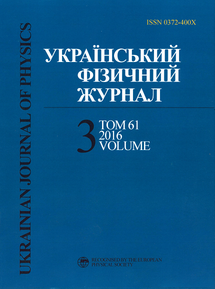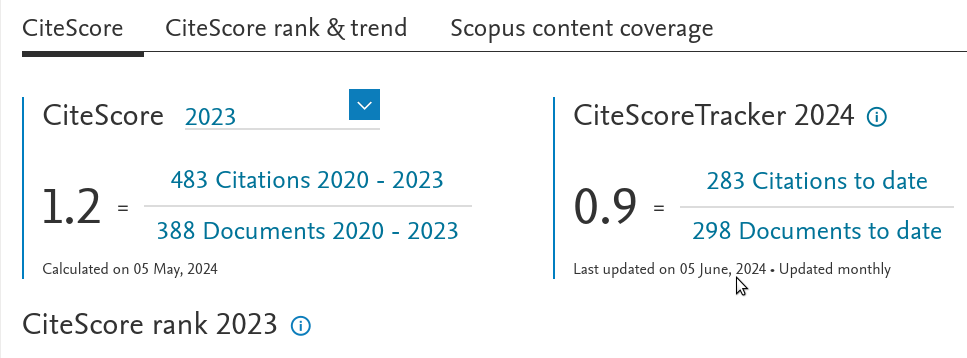Фотоелeктронна емiсiя катода Si–Gd–O
DOI:
https://doi.org/10.15407/ujpe61.03.0248Ключові слова:
адсорбцiя, Gd, O, Si(100), окислення, Gd2O3, робота виходуАнотація
Методами фотоелектронної (ℎv = 1,9—10,2 еВ) та оже-електронної спектроскопiй дослiджено змiни електронних та емiсiйних властивостей фотокатода на основi багатошарової структури окислених атомiв Gd на пiдкладцi iз Si(100) пiсля напилення на його поверхню додаткових шарiв атомiв Gd та з часом перебування цiєї структури в вакуумi. Було встановлено, що незважаючи на те, що робота виходу фотокатода на окремих етапах дослiджень становила ≈0,5 еВ, фотоемiсiя реєструвалась лише для ℎv ≥ 2,8 еВ. Аналiз отриманих результатiв дослiджень дозволив запропонувати модель iмовiрної енергетичної структури фотокатода, яка узгоджується з експериментальними даними. У вiдповiдностi з цiєю моделлю приповерхнева область фотокатода складається iз Gd2O3 товщиною ≈1 нм i шириною забороненої зони ≈5,3 еВ. Вiдстань вiд рiвня Фермi до дна зони провiдностi в об’ємнiй частинi Gd2O3 дорiвнює ≈2,7 еВ. В забороненiй зонi нижче рiвня Фермi розташованi об’ємнi локалiзованi стани та заповненi поверхневi стани, зумовленi дефектами структури. На поверхнi утворюється складний дипольний шар, вiдповiдальний за зменшення роботи виходу.
Downloads
Опубліковано
Як цитувати
Номер
Розділ
Ліцензія
Ліцензійний Договір
на використання Твору
м. Київ, Україна
Відповідальний автор та співавтори (надалі іменовані як Автор(и)) статті, яку він (вони) подають до Українського фізичного журналу, (надалі іменована як Твір) з одного боку та Інститут теоретичної фізики імені М.М. Боголюбова НАН України в особі директора (надалі – Видавець) з іншого боку уклали даний Договір про таке:
1. Предмет договору.
Автор(и) надає(ють) Видавцю безоплатно невиключні права на використання Твору (наукового, технічного або іншого характеру) на умовах, визначених цим Договором.
2. Способи використання Твору.
2.1. Автор(и) надає(ють) Видавцю право на використання Твору таким чином:
2.1.1. Використовувати Твір шляхом його видання в Українському фізичному журналі (далі – Видання) мовою оригіналу та в перекладі на англійську (погоджений Автором(ами) і Видавцем примірник Твору, прийнятого до друку, є невід’ємною частиною Ліцензійного договору).
2.1.2. Переробляти, адаптувати або іншим чином змінювати Твір за погодженням з Автором(ами).
2.1.3. Перекладати Твір у випадку, коли Твір викладений іншою мовою, ніж мова, якою передбачена публікація у Виданні.
2.2. Якщо Автор(и) виявить(лять) бажання використовувати Твір в інший спосіб, як то публікувати перекладену версію Твору (окрім випадку, зазначеного в п. 2.1.3 цього Договору); розміщувати повністю або частково в мережі Інтернет; публікувати Твір в інших, у тому числі іноземних, виданнях; включати Твір як складову частину інших збірників, антологій, енциклопедій тощо, то Автор(и) мають отримати на це письмовий дозвіл від Видавця.
3. Територія використання.
Автор(и) надає(ють) Видавцю право на використання Твору способами, зазначеними у п.п. 2.1.1–2.1.3 цього Договору, на території України, а також право на розповсюдження Твору як невід’ємної складової частини Видання на території України та інших країн шляхом передплати, продажу та безоплатної передачі третій стороні.
4. Строк, на який надаються права.
4.1. Договір є чинним з дати підписання та діє протягом усього часу функціонування Видання.
5. Застереження.
5.1. Автор(и) заявляє(ють), що:
– він/вона є автором (співавтором) Твору;
– авторські права на даний Твір не передані іншій стороні;
– даний Твір не був раніше опублікований і не буде опублікований у будь-якому іншому виданні до публікації його Видавцем (див. також п. 2.2);
– Автор(и) не порушив(ли) права інтелектуальної власності інших осіб. Якщо у Творі наведені матеріали інших осіб за виключенням випадків цитування в обсязі, виправданому науковим, інформаційним або критичним характером Твору, використання таких матеріалів здійснене Автором(ами) з дотриманням норм міжнародного законодавства і законодавства України.
6. Реквізити і підписи сторін.
Видавець: Інститут теоретичної фізики імені М.М. Боголюбова НАН України.
Адреса: м. Київ, вул. Метрологічна 14-б.
Автор: Електронний підпис від імені та за погодження всіх співавторів.

















